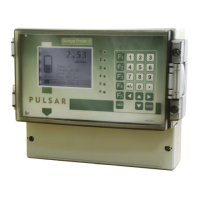Page 61
When in manual simulation, by default test mode will move the level by 0.1m
steps. Altering the increment (P981) will change this value.
In automatic mode, the rate at which the level moves up and down is set by the
increment (P981 in metres, the rate (P982) in minutes, which can be changed to
make the level move up and down faster. E.g. if increment (P981) is set for 0.1m
and rate (P982) is set to 1 min then the level will increase or decrease at a rate of
0.1m/min. To make the simulated level move slower, decrease the value in
increment (P981) or increase the value in rate (P982). To make the simulated
level move faster, increase the value in increment (P981) or decrease the value in
rate (P982).
Using the RS232 Serial Interface
The RS232 serial interface is used to communicate between the Sludge Finder 2
and a PC using the optional Sludge Finder PC software and other associated Pulsar
software packages. To obtain information such as data logging and view echo
traces, upload, download and save parameter files. In addition it can also be used
to control or obtain information using a standard PC or other computer base
equipment. To do so, the default settings for communications port are as follows:
baud rate 19,200, 8 data bits, no parity, 1 stop bit.
The device should be connected as shown in Chapter 2 Installation.
To use the device remotely, you need to log on to start, and log off when finished.
When logged on, Sludge Finder 2 will show “Remote” on the display in place of
the clock. When logged off, the display will return to normal (clock will be
displayed).
All commands should be followed by a carriage return.
The unit will respond either OK or a value if the command is accepted, or NO if
the command is not recognised or is not available.
To log on, send the command
/ACCESS:pppp where pppp is the passcode (P922).
To log off, send the command
/ACCESS:OFF

